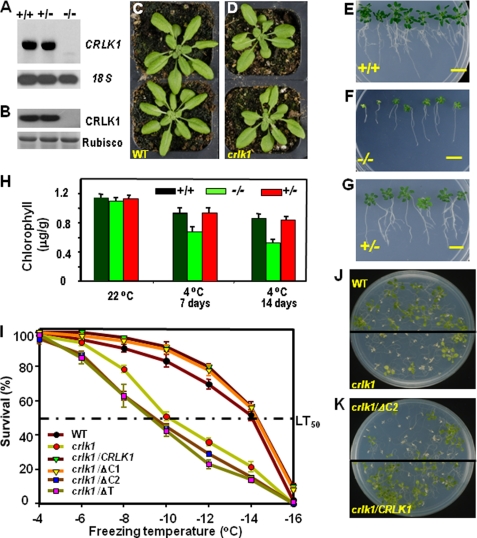FIGURE 4.
crlk1 knock-out mutants are sensitive to low temperature. A, expression of CRLK1 mRNA in crlk1 mutants. The total RNAs (10 μg) from wild-type (+/+), crlk1 heterozygous (+/−), and homozygous (−/−) seedlings were subjected to Northern analysis using the full-length CRLK1 as a probe. 18 S RNA shows equal loading of total RNA. B, expression of CRLK1 protein was abolished in homozygous crlk1 mutants. The total protein (20 μg) isolated from 3-week-old plants were used for Western analysis. Ribulose-bisphosphate carboxylase/oxygenase (Rubisco). C and D, crlk1 mutants had no obvious phenotypic difference as compared with wild-type plants at 22 °C. E–G, crlk1 homozygous plants (−/−) were more sensitive to chilling. The photos were taken after 7 weeks at 6 °C. Bar, 10 mm. H, chlorophyll content in WT and mutant plants. I, freezing survival rates following cold acclimation. The full-length and truncated forms of CRLK1 cDNA were inserted downstream of cauliflower mosaic virus 35S of pCAMBIA 1302. ΔC1 lacks the C-terminal 48 amino acids beyond the CaM-binding region; ΔC2 lacks the C-terminal 71 amino acids including the CaM-binding domain; ΔT lacks the N-terminal transmembrane domain. The average survival rates from three repeats of WT and complementation lines were used. J, crlk1 mutants are less tolerant to freezing than WT plants. Ten-day-old seedlings grown at 22 °C were incubated for 4 days at 4 °C before freezing treatment at −14 °C. The picture was taken 12 days after the freezing treatment. K, freezing tolerance test showing that complementation with truncated CRLK1 lacking the C-terminal CaM-binding site (crlk1/ΔC2) cannot rescue the freezing sensitivity.

